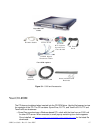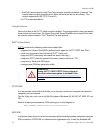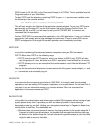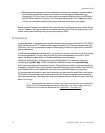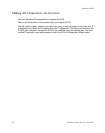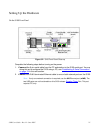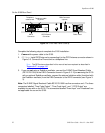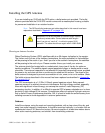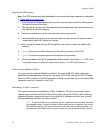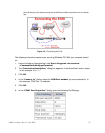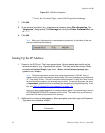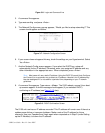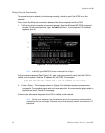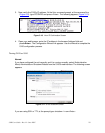
S100 User Guide – Rev. D – June 2005 23
2
5
3
Installing the GPS Antenna
If you are installing an S100 with the GPS option, a bullet antenna is provided. The bullet
antenna provided with the S100 GPS version comes with a weatherproof housing, suitable
for permanent installation in an outdoor location.
Note: The GPS and bullet antennas and cables described in this manual have been
replaced as described in
“Appendix E” on page 141.
Choosing an Antenna Location
Global Positioning System (GPS) satellites orbit at an 56 degree inclination to the equator.
The further north you are in the northern hemisphere, the more probable it is that satellites
will be passing to the south of you. And if you are in the southern hemisphere, the satellites
will be passing to the north of you. Please consider this as you install your antenna.
The antenna should be located with an unobstructed, clear view of the sky for optimum
tracking conditions. The satellite signals cannot penetrate foliage, or dense wood or metal
structures. The antenna’s operation is not affected if it is partially covered with snow, provided
the snow is dry and does not form a continuous ice sheet on the surface. The shape of the
bullet antenna is designed to prevent accumulation of rain, snow, or ice on its surface. (Note:
The bullet antenna described in this manual has been replaced as described in “Appendix
E” on page 141.)
The GPS transmission is a 1.5 GHz (L1Band) spread-spectrum signal. Being spread-
spectrum means it is relatively immune to interference. But high energy sources, especially
those with significant in-band energy, can swamp the receiver’s radio frequency (RF)
processing circuitry. In addition, it is difficult to operate GPS at power substations or in close
proximity to high-voltage 60 Hz sources. Symmetricom offers an optional high-gain antenna
that is useful in heavy interference situations. Still, it is best to locate the antenna away from
radiating sources to avoid degradation in antenna performance.
Outdoors
Install the antenna, using the mast and mounting brackets, with a clear view of the sky, and
away from radio frequency interference. It should be mounted vertically, in a location with an
unobstructed view of 30° above the horizon. Be sure to position it at least two meters above
other active receiving antennas, and shield it from transmitting antennas.
WARNING: Do not cut the cable to a shorter length. Instead,
bundle any excess cable. Correct antenna cable length—
even if you do not “use it all”—is critical to proper S100
operation. The cable should have a gain within 15dB–25dB.



